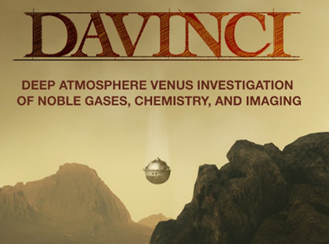DAVINCI Mission of NASA
- 11 Jun 2022
NASA will launch the Deep Atmosphere Venus Investigation of Noble gases, Chemistry and Imaging (DAVINCI) mission in 2029.
- The mission will be the first to study Venus through both flybys and descent.
- The spacecraft is expected to explore the layered Venusian atmosphere and reach its surface by June 2031.
- Only two NASA missions have previously visited the second planet from our sun -- Pioneer in 1978 and Magellan in the early '90s.

Mission Objective
- DAVINCI, a flying analytical chemistry laboratory, will measure critical aspects of Venus’ massive atmosphere-climate system for the first time.
- It will also provide the first descent imaging of the mountainous highlands of Venus while mapping their rock composition and surface relief at scales not possible from orbit.
- The mission supports measurements of undiscovered gases present in small amounts and the deepest atmosphere, including the key ratio of hydrogen isotopes – components of water that help reveal the history of water, either as liquid water oceans or steam within the early atmosphere.
Spacecraft and Probe
- Under the DAVINCI mission, NASA will send a spacecraft and a probe to Venus.
- The mission’s carrier, relay and imaging spacecraft (CRIS) has two onboard instruments that will study the planet’s clouds and map its highland areas during flybys of Venus and will also drop a small descent probe with five instruments that will provide new measurements at very high precision during its descent to the hellish Venus surface.
Three Venus Gravity Assists
- DAVINCI mission will make use of three Venus gravity assists, which will save fuel by using the planet’s gravity to change the speed and/or direction of the CRIS flight system.
- The first two gravity assists will set CRIS up for a Venus flyby to perform remote sensing in the ultraviolet and the near infrared light, acquiring over 60 gigabits of new data about the atmosphere and surface.
- The third Venus gravity assist will set up the spacecraft to release the probe for entry, descent, science, and touchdown, plus follow-on transmission to Earth.
Flyby & Descent
- The first flyby of Venus will be six and half months after launch and it will take two years to get the probe into position for entry into the atmosphere over Alpha Regio with the goal of measuring the landscapes of Venus at scales ranging from 328 feet (100 meters) down to finer than one meter. Such scales enable lander style geologic studies in the mountains of Venus without requiring landing.
- Once the CRIS system is about two days away from Venus, the probe flight system will be released along with the titanium three foot (one meter) diameter probe safely encased inside. The probe will begin to interact with the Venus upper atmosphere at about 75 miles (120 kilometers) above the surface. The science probe will commence science observations after jettisoning its heat shield around 42 miles (67 kilometers) above the surface. With the heat shield jettisoned, the probe’s inlets will ingest atmospheric gas samples for detailed chemistry measurements of the sort that have been made on Mars with the Curiosity rover. During its hour-long descent to the surface, the probe will also acquire hundreds of images as soon as it emerges under the clouds at around 100,000 feet (30,500 meters) above the local surface.
Other Future Mission to Venus
- EnVision: EnVision (to be launched by 2031) is a European Space Agency-led mission in partnership with NASA. It will be the first mission to investigate Venus from its inner core to its upper atmosphere.
- VERITAS: The VERITAS (Venus Emissivity, Radio Science, InSAR, Topography, and Spectroscopy) mission of NASA (to be launched around 2028) will map the surface of planet Venus in high resolution.
EnVision will work in synergy with NASA’s forthcoming VERITAS (Venus Emissivity, Radio Science, InSAR, Topography, and Spectroscopy) and DAVINCI+ (Deep Atmosphere Venus Investigation of Noble gases, Chemistry, and Imaging) missions to provide the most comprehensive study of Venus ever.
| Some Interesting Features of Venus
|




